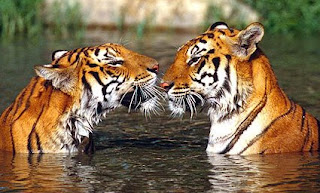The Fishing Cat (Prionailurus viverrinus) is a medium-sized wild cat of South and Southeast Asia. In 2008, the IUCN classified the fishing cat as endangered since they are concentrated primarily in wetland habitats, which are increasingly being settled, degraded and converted. Over the last decade, the fishing cat population throughout much of its Asian range declined severely. Fishing cat are endangered due to their dependence on wetlands, which are increasingly being settled and converted for agricultural use, and also due to human over-exploitation of local fish stocks. It is believed to be extirpated in Afghanistan, it may already be gone from Malaysia and China, and it has become rare throughout its remaining distribution range.

The tiger (Panthera tigris) is the largest cat species. Their most recognizable feature is a pattern of dark vertical stripes on reddish-orange fur with lighter underparts.
In zoos, tigers have lived for 20 to 26 years, which also seems to be their longevity in the wild.[5] They are territorial and generally solitary but social animals, often requiring large contiguous areas of habitat that support their prey requirements. This, coupled with the fact that they are indigenous to some of the more densely populated places on earth, has caused significant conflicts with humans. Tigers once ranged widely across Asia, from Turkey in the west to the eastern coast of Russia. Over the past 100 years, they have lost 93% of their historic range, and have been extirpated from southwest and central Asia, from the islands of Java and Bali, and from large areas of Southeast and Eastern Asia. Today, they range from the Siberian taiga to open grasslands and tropical mangrove swamps. The remaining six tiger subspecies have been classified as endangered by IUCN.
The leopard (Panthera pardus) is a member of the Felidae family and the smallest of the four "big cats" in the genus Panthera, the other three being the tiger, lion, and jaguar. The leopard was once distributed across eastern and southern Asia and Africa, from Siberia to South Africa, but its range of distribution has decreased radically because of hunting and loss of habitat. It is now chiefly found in sub-Saharan Africa; there are also fragmented populations in the Indian subcontinent, Sri Lanka, Indochina, Malaysia, Indonesia, and China. Because of its declining range and population, it is listed as a "Near Threatened" species on the IUCN Red List.
Compared to other members of the Felidae family, the leopard has relatively short legs and a long body with a large skull. It is similar in appearance to the jaguar, but is smaller and more slightly built. Its fur is marked with rosettes similar to those of the jaguar, but the leopard's rosettes are smaller and more densely packed, and do not usually have central spots as the jaguars do.
Leopards live mainly in grasslands, woodlands, and riverine forests. They are usually associated with savanna and rainforest, but leopards are exceptionally adaptable: in the Russian Far East, they inhabit temperate forests where winter temperatures reach a low of −25 °C (−13 °F). Leopards are known for their ability in climbing, and have been observed resting on tree branches during the day, dragging their kills up trees and hanging them there, and descending from trees headfirst. They are powerful swimmers, very agile, and can run at over 58 kilometres per hour . and jump up to 3 metres. Leopards are versatile, opportunistic hunters, and have a very broad diet, consists mostly of ungulates and monkeys, but they also eat rodents, reptiles, amphibians, insects, birds (like the Vulturine Guineafowl), fish and sometimes smaller predators (such as bat-eared foxes, martens, and jackals).
The jungle cat (Felis chaus) is a medium-sized cat native to Asia from southern China in the east through Southeast and Central Asia to the Nile Valley in the west. It is listed as Least Concern in the IUCN Red List of Threatened Species as it is widespread and common particularly in India. Population declines and range contraction are of concern, particularly in Egypt, in the Caucasus, and in southwestern, Central and Southeast Asia.
Geographic variation in the jungle cat is quite considerable. Due to the small tuft on the ears it is also called the jungle lynx but is not related to the lynx
This species of cat is capable of being domesticated under certain conditions. Cat breeders have been able to hybridize jungle cats with certain domestic cats, producing such breeds as the "chausie" (Jungle Cat x domestic cat) and the "jungle bob" (Jungle Cat x Pixie Bob).
Issued on 13/04/1998.




No comments:
Post a Comment